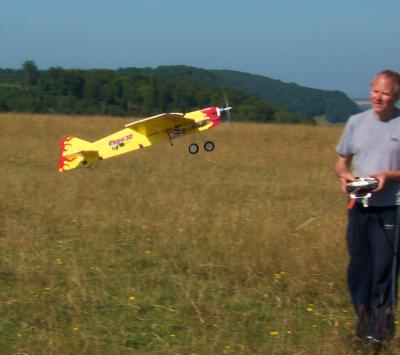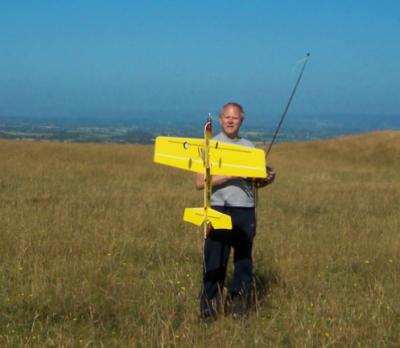|
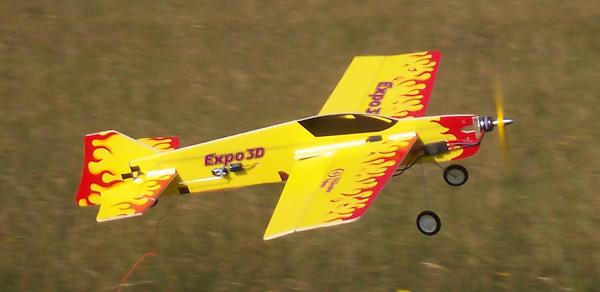
Click image for bigger photo
The kit is supplied with a 300 brushed
motor and all the part including 5 min epoxy. To fly the model you also need 3
micro servos, speed controller, batteries and receiver.
The model is made of paper covered white foam strengthened with carbon rod
where needed. There is no building, it slots together. I chose to use a
brushless motor and made a small bracket to mount it. The servos are stuck
in with silicone, the speed controller and receiver stuck on with double sided tape, the
battery pack is held on with Velcro on the C of E. About an hour should be
enough,. put the batteries on charge before you start
|
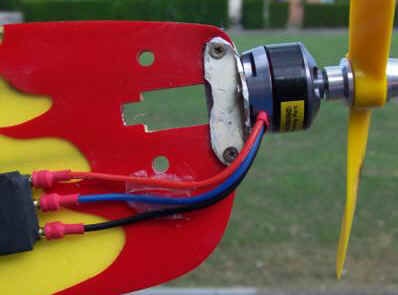
Eflight 370 12 pole brushless motor, plenty of torque
from a very light motor,. fitted with a crude home made bracket.
static current draw with a
9 X 3.8 prop is 9 amps full throttle. This motor remains cool
even after periods of prop hanging. |
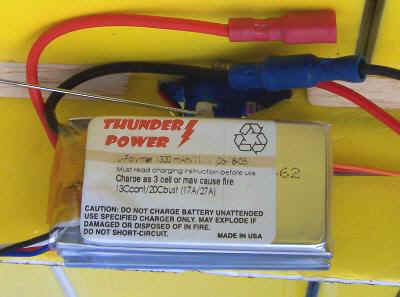
3 cell 11 volt 1350ma lithium polymer battery 80
grams and capable of 17 amps. about 20 minutes flight time. This
battery pack also remains cool even after heavy use or
charging.
|
|
|
Flying
Suit you sir? Yes, if you can fly a Zagi without
thumping it into the ground, you can fly this, but with so
much power and fast response it is not a trainer. It could be flown in the
park or in your back garden, skilled pilots prop hang
them indoors. With
the brushless motor it is best flown where there is plenty of space to
start with. Flights from balconies should be possible, just make sure the
prop has stopped before catching it. .
The first proper flight I had was at our Barbeque at the Bristol Gliding
club; all control surfaces were set to neutral, no mixers or rates used,
set up as a
basic 4 channel.
Half throttle a limp throw and it climbed steadily
but wanted to go left, 6 clicks of right aileron trim counteracted
the prop reaction and had it flying straight. It was very easy to fly but I was rubbish
with the throttle and rudder. I managed a couple of rolling circles, a flat
rudder turn loops and bunts. I tried a spin, this resulted in a spiral
dive due to a forward C of
E
The 3D can perform any aerobatic maneuver; the wing is a flat sheet so
it flies the same inverted. There is enough power to hover on part
throttle, I find this
very hard, there are two ways to learn this trick, low down so it does not have far to fall,
or high enough to recover. Rolling hesitation
circles, knife edge circles and loops, rolling loops should be easy with
this model for the aerobatic pilot. Power flying needs coordination of the
4 stick movements something I need to learn. The 3D has a very large
speed range from zero to about 40MPH, with the fan blowing over the
surfaces there is no stall and full control,
Spec
wing span:- 32"
length:- 30"
all up weight 12 oz
radio Futaba 5 channel park flier
servos 3 Hi-tec HS 55s
motor E-flight 370 with controller
Battery 3 cell 1350 Li_Poly
Cost with brushed motor £34
Li_poly battery £12 to £35
Brushlees motor and controller £60
I like it, Great fun, the Ikarus flies better but is very
fragile and more building is required. Learning to fly a 3D model is a
challenge.
There is a design fault, the battery is below the wing giving too much pitch
and roll stability, useful for the first flights but would spoil acrobatics
for the expert.
Phil
Please note, Li-poly batteries need a foolproof dedicated
charger, a multi charger is not safe, the cells need individual monitoring
and must not go over 4.235 volts.
They also need a battery cut off in the speed controller to stop the motor
before the cells discharge below 3 volts. The speed controller I used
needs a fully charged battery to set low voltage cut-out, reconnecting a
partly discharged battery would disable this function
The Battery should not be over stressed, discharge well below the maximum
rating and charge at 0.5 C to 0.7C they are charged when the current
drops to 0.1C at 4.2 volts. watch this video of an overcharged battery click
here
|



